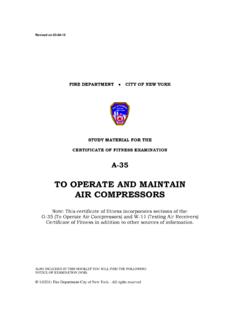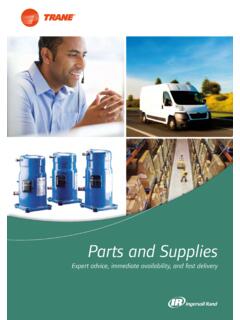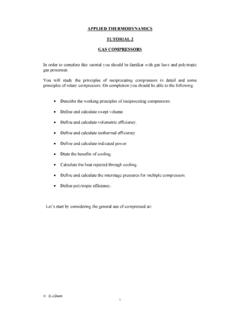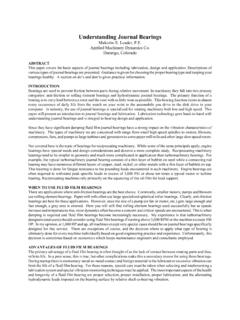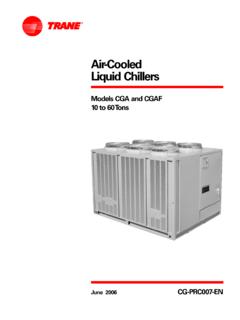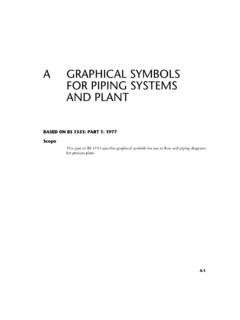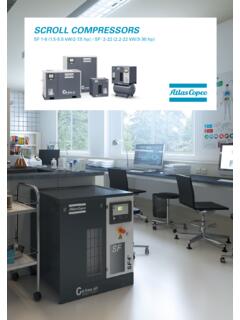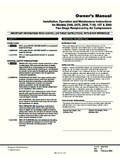Transcription of The US Natural Gas Compression Infrastructure ...
1 The US Natural Gas Compression Infrastructure : Opportunities for Efficiency Improvements Klaus Brun, Director R&D, Elliott Group University Turbine Systems Research Symposium October 2018. All figures courtesy of Elliott Group, Solar Turbines Inc., Southwest Research Institute, and General Electric The Journey of Natural Gas Machinery Applications Upstream Midstream Downstream Background: Oil & Gas Compressors Compressors are used for Natural gas gathering, transport, processing, storage, and distribution (fuel gas). US has approximately 1,700 midstream Natural gas pipeline compressor stations with a total of 5,000-7,000 compressors US has approximately 13,000-15,000 smaller compressors in upstream and 2,000-3,000 compressors (all sizes) in downstream oil & gas and LNG applications.
2 DOE estimates that 2-3% of US Natural gas is utilized by oil & gas compressors (includes consumption and leakage). Oil & Gas Compressors are High Visibility Targets for Efficiency Improvements US Natural Gas Production Source: US DOE EIA, Wood Mackenzie Plenty of Gas for Growth and then some for LNG Export Energy Costs What it means to an economy! 2015 USA: 75 bcf/d consumption at $ = 335 million Dollars per day = 122 billion Dollars per year The price of 80-100 new large NGCC (750MW Each). power plants per year Pipeline Compression History: Horizontal compressor Original pipeline prime mover first installed in the 1930s.
3 Internal combustion spark ignited, four cylinder unit (1700 bhp supercharged). running at 125 rpm. Power cylinders are horizontal-opposing. Most of these units (Cooper and Worthington) have been replaced with integral horsepower Some remain in operation with Tennessee Gas, Northern Natural and Panhandle Eastern. All figures courtesy of Elliott Group, Solar Turbines Inc., Southwest Research Institute, and General Electric Pipeline Compression History: Gas Integral Compressors Internal combustion, spark ignited, engine driver with integral reciprocating compressor (the engine and compressor share the same crankshaft).
4 Majority of these units were installed from the 1950- 1970. Integrals are still the workhorse for the industry. Units are either 2 or 4 cycle and are typically supercharged. Horsepower ranges 600 - 17,000 bhp. Manufacturers have included Cooper-Bessemer, Dresser Rand, Ingersoll Rand, Worthington and Clark. Massive in size, complex auxiliary systems, costly to operate. Excellent efficiencies above 40%. All figures courtesy of Elliott Group, Solar Turbines Inc., Southwest Research Institute, and General Electric Pipeline Compression History: Gas Separable Compressors The engine and compressor have individual crankshafts and are coupled as separate devices on a unitized skid.
5 Introduced late 1960s and still major market player. Initially suffered as they were high speed machines (350 - 1200 rpms) with unacceptable vibrations. Recent years made a come back and are now displacing some of the larger integral units. Pipelines purchase primarily Ariel Compressors through packagers . Other vendors are GE, Cameron, and Dresser. All figures courtesy of Elliott Group, Solar Turbines Inc., Southwest Research Institute, and General Electric Pipeline Compression History: Gas Turbine Driven Centrifugals Since the 1970s, Industrial Gas Turbines are currently the prime mover of choice for most mainline applications.
6 Gas Turbines are more reliable than internal combustion engines, have very low maintenance costs and are basically clean burn units (low emissions). Relatively low efficiency of 20% to 35%. The original gas turbines (1960s-1970s) were classified as aero derivative machines and are typically jet engine platforms converted to drive a centrifugal compressor . Later industrial gas turbines were introduced. Gas turbine units are normally used for higher horsepower (7,000-40,000 bhp) applications. Most US operators use Solar Turbines, GE, and Siemens. All figures courtesy of Elliott Group, Solar Turbines Inc., Southwest Research Institute, and General Electric Pipeline Compression History: Other Equipment Configurations Fixed Low Speed Electric Reciprocating Fixed Medium Speed Electric Reciprocating VFD Reciprocating Conventional Fixed-Speed Electric Centrifugal Conventional Fixed Speed with Voith Vorecon Voith Vorecon Hydrodynamic Fluid Coupling Conventional EMD VFD-Geared Centrifugal Screw Compressors and other PD Compressors High Speed Motor VFD Direct Drive Centrifugal All figures courtesy of Elliott Group, Solar Turbines Inc.
7 , Southwest Research Institute, and General Electric US Natural Gas Pipelines and Compression Stations Source: US DOE EIA, Wood Mackenzie - million miles of pipelines - 850-900 mainline compressor stations, 800-900 booster stations (+ 15,000 gas gathering machines). - Average age of pipeline compressors: 25-30 years - Consume/lose about of US NG = tcf/y = 3-4 billion US Dollars per year Minimum of 5,000,000 hp of Compression must be replaced in next 15 years on US pipelines. World's Pipelines Middle Eats North America South Europe America Oceania Asia Source: US DOE EIA, Wood Mackenzie Largest Number of Installed Machines: Upstream - Gas Gathering: Mostly Small Recips (4khP).
8 - Flexible Distributed installation and Compression operation - Often high leakage 2250 bhp Diesel Engine: 15,000lbs - Low emissions Central - High reliability Compression - Lower efficiency 7800 hp (ISO) Gas Turbine: 11,000 lbs Well-head Compression versus central Compression : - Wet gas Compression technology impact - Air emissions requirements impact Pipeline Operating Conditions Design Reality 25,000 40000. 82%. 85%. 35000 1 UNIT 2 UNITS 3 UNITS IN PARALLEL. 85%. 20,000 82% 30000. 78% 25000. 86%. 15,000 74%. HEAD (FT). 20000. 15000. SITE POWER AT 75F. 10,000 10000. 5000. Pipeline Resistance 5,000 0. Curve 0 5000 10000 15000 20000 25000.
9 -5000. 1,000 2,000 3,000 4,000 5,000 6,000 ACFM. Pipeline compressors rarely operate near their design point: - Reduced driver efficiency - Reduced compressor efficiency - Gas recycling or other flow control losses All figures courtesy of Elliott Group, Solar Turbines Inc., Southwest Research Institute, and General Electric O&G Machinery Compression HP Requirements Upstream Midstream Downstream Gas Gathering Pipeline Distribution Gas Plant (PowerGen). Reinjection (LNG/GTL). Gas Lift PowerGen Field Export 20-40 kHp per 5-15 kHp per 1-5k Hp per 100 MMSCFD 100 MMSCFD 100 MMSCFD. ( Compression power per NG production rate).
10 Upstream production has largest HP requirements. Most of it for gas gathering utilizing <2000 Hp recip compressors. Applications-Pipeline Transmission and Boost No. of Units (US). All figures courtesy of Elliott Group, Solar Turbines Inc., Southwest Research Institute, and General Electric 2000 4000 6000. Pipeline Compression Equipment Most Commonly Used Gas Turbine Driven Centrifugal compressor : High Speed Separable Recip compressor : - Simple cycle gas turbine driver - Gas Engine driver - Direct drive compressor (6,000-20,000 rpm) - Direct drive compressor (1200-1600 rpm). - Centrifugal compressor with 1-2 impeller stages - 2-4 double acting cylinder stages Electric Motor Drive: - Centrifugal and recip compressors - With or without gearbox - Fixed speed or variable speed (VFD).


